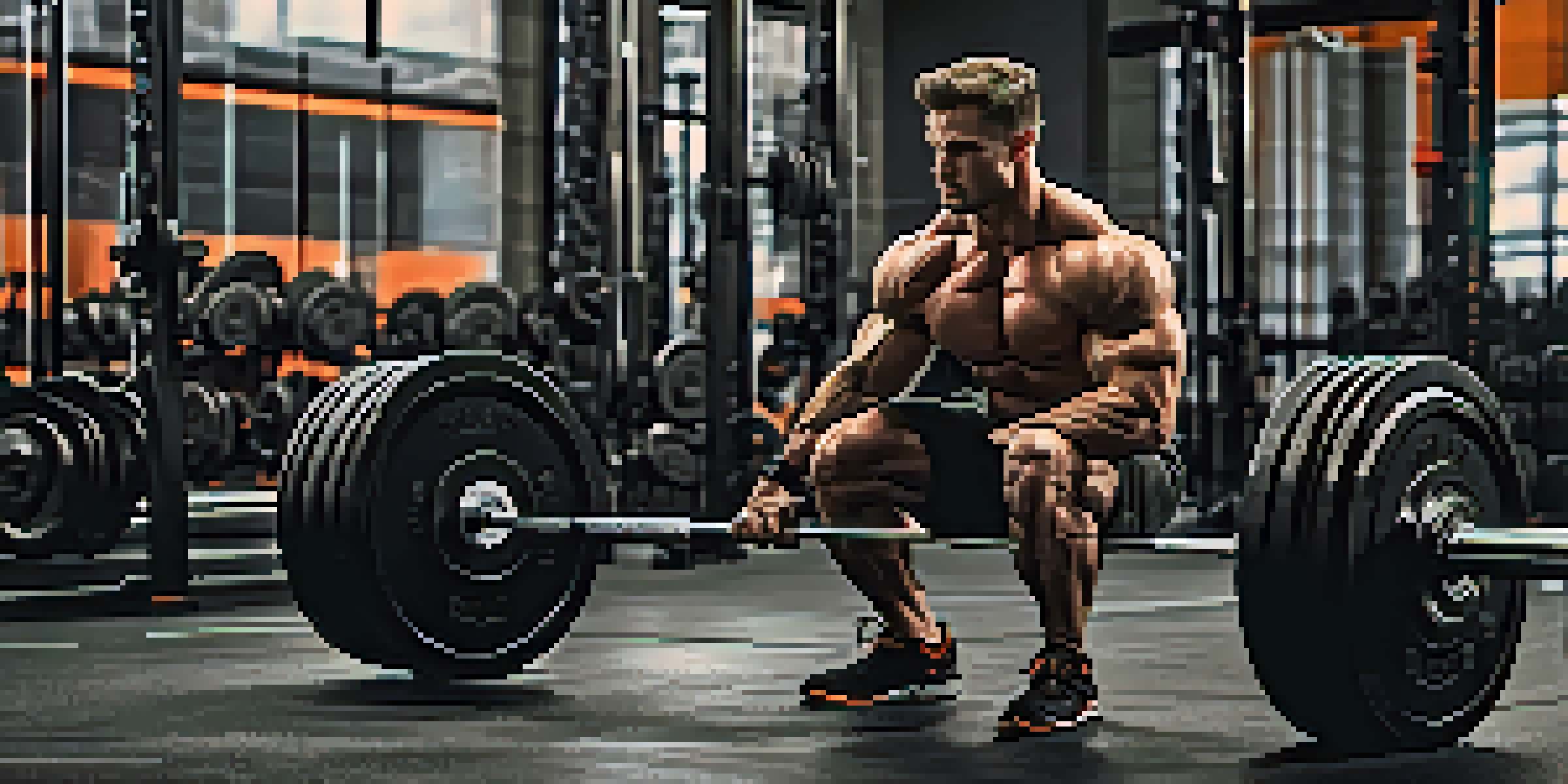Powerbuilding: Merging Powerlifting and Bodybuilding Techniques

Understanding Powerbuilding and Its Origins
Powerbuilding is a hybrid training approach that combines elements of powerlifting and bodybuilding. By merging the focus on strength from powerlifting with the aesthetic goals of bodybuilding, powerbuilding offers a unique pathway to physical fitness. This methodology has roots in the fitness community, where lifters sought to enhance both their strength and appearance.
Strength does not come from physical capacity. It comes from an indomitable will.
The origins of powerbuilding can be traced back to athletes who wanted the best of both worlds. They realized that lifting heavy weights not only builds muscle but also improves overall physique. This trend has gained traction in recent years, appealing to those who want to look good while lifting heavy.
In essence, powerbuilding allows individuals to achieve a balanced physique that is not only strong but also visually impressive. This approach encourages a well-rounded fitness journey that prioritizes functional strength alongside aesthetic development.
Key Differences Between Powerlifting and Bodybuilding
At first glance, powerlifting and bodybuilding might seem similar, but they have distinct goals. Powerlifting primarily focuses on maximizing strength in three core lifts: squat, bench press, and deadlift. On the other hand, bodybuilding emphasizes muscle hypertrophy and symmetry, with a wide variety of exercises and techniques to achieve a sculpted physique.

While powerlifters aim to lift the heaviest weights possible, bodybuilders work on developing muscle size and definition. This difference in focus leads to varied training regimens, nutrition plans, and even mental approaches. Powerbuilders benefit from understanding both disciplines, allowing them to strategize their workouts for optimal results.
Powerbuilding: Strength Meets Aesthetics
Powerbuilding combines powerlifting's strength focus with bodybuilding's aesthetic goals, creating a balanced fitness approach.
Incorporating elements from both fields can lead to a more comprehensive fitness routine. By recognizing these differences, powerbuilders can tailor their training to meet their personal goals, whether that’s lifting heavier weights or achieving a more defined look.
Essential Techniques for Powerbuilding Workouts
Powerbuilding workouts typically include a mix of heavy compound lifts and hypertrophy-focused accessories. Compound lifts, like squats and deadlifts, are crucial as they engage multiple muscle groups and promote overall strength. Following these with accessory exercises, such as isolation movements, helps target specific muscles for growth.
The only bad workout is the one that didn’t happen.
An effective powerbuilding program often follows a structured routine that alternates between strength-focused and hypertrophy-focused days. For instance, one day might prioritize low-rep, high-weight training for strength, while another day focuses on higher-rep, moderate-weight work for muscle size. This combination maximizes both strength gains and muscle development.
Additionally, incorporating progressive overload is key in powerbuilding. This means gradually increasing the weight, frequency, or number of repetitions to continually challenge the muscles, which leads to consistent improvement over time. It’s this blend of techniques that makes powerbuilding a versatile and effective training method.
Nutrition: Fueling Your Powerbuilding Journey
Nutrition plays a vital role in any fitness regimen, and powerbuilding is no exception. To support both strength gains and muscle growth, it’s essential to consume a balanced diet rich in protein, carbohydrates, and healthy fats. Protein, in particular, helps repair and build muscle tissue after intense workouts.
Many powerbuilders aim for a calorie surplus to fuel their workouts and recovery. This means consuming more calories than the body burns, allowing for muscle growth while still maintaining strength. However, it’s important to choose nutrient-dense foods to avoid excessive fat gain during this process.
Nutrition Fuels Powerbuilding Success
A balanced diet rich in protein and healthy fats is essential for supporting strength gains and muscle growth in powerbuilding.
Hydration is also crucial, as it supports performance and recovery. Drinking enough water helps maintain energy levels and reduces the risk of injury during heavy lifts. By prioritizing nutrition, powerbuilders can enhance their training results and overall well-being.
The Role of Recovery in Powerbuilding Success
Recovery is an often-overlooked aspect of powerbuilding, yet it’s essential for achieving optimal results. Adequate rest allows muscles to repair and grow stronger after intense workouts. Without sufficient recovery time, lifters may experience fatigue and diminished performance, which can hinder their progress.
Incorporating rest days into a powerbuilding routine is vital. These days allow for physical and mental rest, helping prevent burnout and injuries. Additionally, active recovery techniques, such as light cardio or stretching, can aid in muscle recovery while keeping the body engaged.
Prioritizing sleep is another key component of recovery. Aim for 7-9 hours of quality sleep each night to support hormone regulation and muscle repair. By focusing on recovery, powerbuilders can ensure they remain strong, healthy, and ready for their next workout.
Common Mistakes to Avoid in Powerbuilding
Despite its benefits, powerbuilding can lead to some common pitfalls if not approached carefully. One frequent mistake is neglecting proper form in pursuit of heavier weights. This can lead to injuries and setbacks, so it’s crucial to prioritize technique over lifting more weight.
Another error is failing to balance strength and hypertrophy training. Many powerbuilders may focus too heavily on one aspect, neglecting the other. A well-rounded program should include both types of training to maximize overall results and prevent plateaus.
Recovery is Key to Progress
Adequate recovery, including rest days and quality sleep, is crucial for muscle repair and overall performance in powerbuilding.
Lastly, underestimating the importance of nutrition can hamper progress. Fueling the body with the right nutrients is essential for recovery and performance. By avoiding these common mistakes, powerbuilders can ensure a more effective and sustainable training journey.
How to Get Started with Powerbuilding
Getting started with powerbuilding doesn’t have to be complicated. Begin by assessing your current fitness level and defining your goals—do you want to increase strength, build muscle, or both? This self-assessment will help you tailor your training program to meet your needs.
Next, consider seeking guidance from experienced lifters or trainers, especially if you’re new to either powerlifting or bodybuilding. They can provide valuable insights on proper techniques and help you create a balanced program that incorporates both strength and hypertrophy elements.

Finally, commit to consistency and patience. Powerbuilding is a journey that requires time and dedication. As you progress, celebrate your achievements, whether they are lifting heavier weights or noticing physical changes in your body. This mindset will keep you motivated and on track toward your powerbuilding goals.